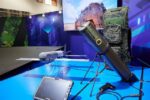Northrop Grumman’s B-21 Raider program has entered a critical new phase with multiple aircraft undergoing ground testing at the company’s Palmdale facility. As the U.S. Air Force prepares for initial operational capability (IOC) later this decade, discussions are underway to accelerate production of the stealth bomber amid growing strategic demand and industrial readiness.
Multiple B-21s in Ground Test as Fleet Grows Beyond First Flight Article
According to Tom Jones, president of Northrop Grumman Aeronautics Systems, “multiple” B-21 aircraft are now engaged in various stages of ground testing at Air Force Plant 42 in Palmdale, California. This includes the first flight test article—tail number 0001—which conducted its maiden flight on November 10, 2023. The remaining aircraft are believed to be part of the Engineering and Manufacturing Development (EMD) lot.
The confirmation that more than one airframe is undergoing ground evaluation signals a significant step forward from earlier phases where only a single prototype had been visible. The presence of multiple test articles supports parallel validation of systems integration, low-observable coatings performance under environmental stressors, and propulsion system behavior under static conditions.
Jones emphasized that the program is on track and that lessons from initial flight tests are being rapidly integrated into follow-on builds. “We’re learning every day,” he said during a roundtable with reporters at AFA’s Warfare Symposium in Aurora, Colorado.
Production Acceleration Discussions Signal Confidence in Design Maturity
The U.S. Air Force is currently negotiating with Northrop Grumman to increase the pace of production beyond current plans. While precise figures remain classified due to operational security concerns surrounding force structure and basing plans for strategic bombers, officials suggest that the current rate is being reassessed based on successful early testing outcomes and global threat dynamics.
The original contract awarded in 2015 under the Long Range Strike-Bomber (LRS-B) program envisioned delivery of at least 100 aircraft over time. However, recent statements by senior defense officials—including Secretary of the Air Force Frank Kendall—indicate openness to exceeding that number if budgetary and industrial conditions allow.
This aligns with broader Department of Defense (DoD) efforts to recapitalize aging platforms like the B-1B Lancer and B-2 Spirit while ensuring survivability against advanced air defense systems fielded by near-peer adversaries such as China and Russia.
B-21 Design Philosophy Prioritizes Modularity and Survivability
The B-21 Raider represents a generational leap in bomber design philosophy. Unlike legacy platforms retrofitted over decades to accommodate new weapons or sensors, the Raider was conceived from inception as a digital-native platform built around open-systems architecture (OSA). This allows rapid insertion of emerging technologies without costly redesigns or extended downtime for upgrades.
A key focus area remains its low-observable (LO) profile across multiple spectra—radar cross-section (RCS), infrared signature management, acoustic suppression—as well as electronic warfare resilience. The aircraft is designed for deep penetration missions into contested environments where integrated air defense systems (IADS) present significant risk to legacy assets.
Further enhancing survivability is its ability to operate autonomously or as part of manned-unmanned teaming constructs—a feature likely enabled by its software-defined avionics backbone and secure datalink integration (potentially including Link 16 successors).
Flight Testing Continues Ahead of IOC Target Date
The first flight from Palmdale to Edwards AFB last November marked a pivotal milestone but was only an initial sortie within what will be an extensive test campaign led by Air Force Test Center’s Detachment 6 under Global Strike Command oversight. The focus now shifts toward envelope expansion flights covering range performance validation, weapons bay integration checks (including nuclear certification pathways), LO durability assessments after repeated sorties, and maintainability trials under operational tempo simulations.
While no official IOC date has been confirmed publicly beyond “mid-to-late decade,” indications suggest that Block 1 production units could enter squadron service before FY2028 if current progress holds steady. The USAF has previously stated that IOC would require not just delivery but also sufficient trained crews and support infrastructure at designated operating bases—likely Ellsworth AFB or Whiteman AFB based on prior basing studies.
Strategic Implications Amid Indo-Pacific Rebalancing
The push toward faster fielding of additional B-21s comes amid heightened concern over pacing threats posed by China’s rapid military modernization—especially its anti-access/area-denial (A2/AD) capabilities across maritime East Asia. The Raider’s range (~9,300 km unrefueled), payload flexibility (~13–15 tons internal), and LO characteristics make it uniquely suited for penetrating strike missions against hardened targets such as command bunkers or missile silos deep within contested zones like mainland China or North Korea.
Its role will also complement other long-range assets such as AGM-181 Long Range Stand Off Weapon (LRSO), hypersonic missiles under development like HACM/ARRW variants (if revived), and future collaborative combat aircraft swarms envisioned under NGAD frameworks.
Industrial Base Readiness Key to Scaling Up
A critical enabler for any production ramp-up will be supply chain resilience across stealth materials fabrication (e.g., radar absorbent composites), advanced avionics suppliers, propulsion system vendors (notably Pratt & Whitney’s F135 derivative engines), and skilled labor availability at Palmdale’s production line.
Northrop officials have stated they’ve invested heavily in digital twin technologies and modular tooling approaches enabling concurrent build/test cycles—a departure from traditional linear assembly lines seen in prior programs like F-22 or even F-35 early variants.
The Pentagon’s commitment to multi-year procurement contracts could further incentivize subcontractor investments needed for surge capacity while reducing per-unit costs through economies of scale—a dynamic already seen with programs like KC-46A Pegasus or Columbia-class SSBNs via block buys.
Conclusion: From Prototype to Backbone Bomber
The transition from developmental prototype toward operational fleet centerpiece appears well underway for the B-21 Raider program. With multiple airframes now active on test stands—and negotiations hinting at accelerated procurement—the United States may soon field its most advanced strategic bomber ever built far ahead of earlier expectations. If sustained funding matches industrial readiness and geopolitical urgency continues rising across Eurasia-Pacific theaters, full-rate production could begin before decade’s end—reshaping global deterrence postures for decades ahead.










